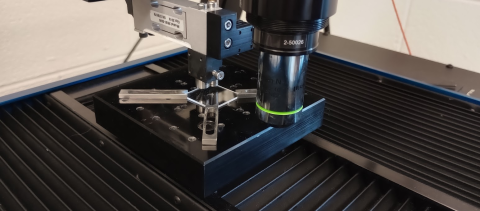Geometry and Surface Topography
The Materials for Opto/Electronics Research and Education (MORE) Center at Case Western Reserve University hosts a range of profilometry and microscopy tools to characterize sample geometry, roughness, height, morphology and shape. Our capabilities extend from the millimeter to the sub-micrometer and nanometer scale.
- Scanning Electron Microscope (SEM): Tescan Vega-3 This 30kV SEM is capable of precisely measuring sample geometry for nanometer scale lateral features. Sputter coating facilities for non-conductive samples are also available.
- Stylus Profilometer: KLA-Tencor P-6 The stylus profilometer uses a 2 micron tip stylus to measure surface geometry and roughness as 2D or 3D surface mapping. This model can measure topographical features from 10 nm up to 300 um height.
- SWLI Optical Profilometer: Zygo New-View 7300 This white light interferometer can precisely characterize surface geometry and roughness as a 3D surface mapping for topographical features with dimensions ranging from nanometer up to 1 mm height.
- Chromatic Optical Profilometer: Nanovea ST400 This is a chromatic profilometer for making precise sample measurements over large surface areas and varied geometries. This model has a 150 mm X-Y stage with a height clearance of 200 mm, and can perform 2D or 3D surface mapping to measure topographical features from 10 nm up to 10 mm height.
- Atomic Force Microscope (AFM): Agilent 5500 SPM This AFM can precisely characterize surface topography and roughness as a 3D surface mapping with nanometer to micrometer scale in all dimensions. Force spectroscopy is also available.
- Optical Microscope: Leica DM2500M The optical microscope is equipped with a range of objectives from 2.5x to 100x 0.85NA and a digital camera.
Mechanical Testing
Microindentation assesses a material's mechanical properties at the micron scale, including hardness. Additional capabilities include scratch and wear analysis at micro and macro levels, which can be paired with profilometry for more detailed analysis.
- Microindenter: Nanovea PB1000 The microindenter at the MORE center is capable of micro- and macro-indentation in the range of 0–40 N load. This model has a 200 mm x 150 mm motorized XY table with 50 mm sample clearance, adjustable up to 140 mm for larger samples. A built-in microscope allows for a range of hardness tests (such as Vickers) to be performed without additional measurements. We offer a range of indentation types including Vickers, conical and spherical tips. Additionally, the microhardness module is capable of scratch and wear measurements.
Materials and Optical Analysis
The MORE Center offers a range of tools to quantify the structure and materials composition of thin-films and other materials.
- Ellipsometer: Horiba UVISEL DUV-NIR Spectroscopic ellipsometers are used to characterize the structure and material properties of surfaces and thin films, including optical properties (permittivity or refractive index), thickness, and surface roughness. Ellipsometry is a non-destructive optical method that analyzes polarized light reflected from a sample. This model is capable of measurements with UV, visible, and near IR light. Additionally, this tool can measure reflectance, transmittance, and absorbance of samples.
- UV-VIS Spectroscopy: Ocean Optics USB400 This fiber-optic spectrophotometer measures absorbance and transmission of liquid and thin-film samples from 200 to 850 nm, to determine optical properties and chemical composition.
- UV-VIS Spectroscopy: Shimadzu UV2101-PC This spectrophotometer measures absorbance, transmission, and reflection of liquid and thin-film samples from 200 to 850 nm, to determine optical properties and chemical composition.
- Spectrofluorometer: Horiba Fluorolog 3 The spectrofluorometer measures both the excitation and emission spectra of photo-luminescent or fluorescent materials. This information is used to investigate the quantum mechanical states of materials, especially dyes. An integrating sphere is also available for absolute quantum yield measurements.
Electronic and Solar Characterization
Parallel to our device fabrication capabilities, the MORE Center offers a suite of tools for characterizing the electronic properties of devices. This includes standard solar evaluation methods.
- Probe station: Micromanipulator 450PM-B The micromanipulator is a general purpose probe station integrated into the glovebox system for operation in an inert environment. The system is integrated with a Keithley 2636B SMU allowing for a range of measurements including 4-point resistance and gated device characterization.
- Solar Simulator and IV station: Oriel Sol2A The solar simulator is designed for standardized solar cell illumination and is integrated into the glovebox system. The system is integrated with a Keithly 2400 SMU for IV measurements.
- External Quantum Efficiency: PV Measurements QEX10 External quantum efficiency (EQE), also known as Incident Photon Conversion Efficiency (IPCE) characterizes the wavelength dependent current generated in a solar cell per incoming photon. The tool is set up for measurements both inside and outside the glovebox system, and has various accessories including lamps for external light bias.



